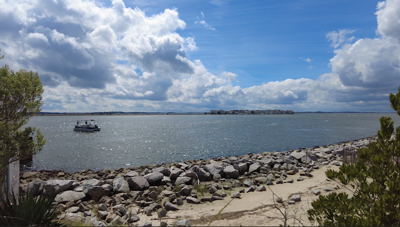REHOBOTH, Del. - The Delaware Center for the Inland Bays has released its 2021 State of the Bays Report that assesses multiple factors of the state’s Inland Bays’ overall health. Those three bays are the Rehoboth Bay Watershed, the Indian River Bay Watershed, and the Little Assawoman Bay Watershed.
The last report was released in 2016. Five years later, the 2021 report’s overall grade for the waters of the Inland Bays remains unchanged at a “Poor” or “D” rating.
The report does note progress since the 2016 assessment. A 2018 change to how and where discharge from Rehoboth Beach’s wastewater treatment system is released, for instance, has resulted in the elimination of a major source of nutrient pollution in the Bays. A previous goal to convert 45,000 Sussex County septic systems to central sewer was also surpassed, seeing 52,884 conversions.
A growing shellfish farming industry, recovering from setbacks due to the COVID-19 pandemic, was also cited as a boon to the water quality and local economy.
Though these improvements were noted, the report went on to suggest there was more work to be done.
Nitrogen inputs remain above healthy limits according to the report, and water quality was described as poor in the tributaries and canals feeding into the Bays. A rapidly booming population on the Eastern Shore is contributing to habitat loss, the report outlines, and the conversion of farms and forest to urban developments has seen increases in pollution.
The report is divided into six separate chapters, or aspects, of the overall Bays’ health. Each is given a status and trend for their condition, which are as follows:
Watershed Condition - Fair status, trending as degrading
Managing Nutrient Pollution - Fair status, no trend
Water Quality - Fair to poor status, no trend
Living Resources - Fair status, no trend
Human Health Risks - Fair status, no trend
Climate - Poor status, trending degrading
Climate change was especially noted as an “existential threat to the Inland Bays and their surrounding communities.” The report goes on to point out that the last ten years were the hottest on record in southern Delaware and that severe storms are becoming more common.
“The Inland Bays are changing in direct response to a changing climate and so too will the habitats, wildlife, and communities that depend on this delicate system,” the report reads. “The health of the Bays, their living resources, and people are inextricably linked. The Center and its partners are committed to working together to clean Bay waters and preserve and restore natural habitats across the watershed.”
The report names proactive planning and strong environmental policies as key in protecting the Bays and mitigating the impacts of global warming and rising seas. While progress has been made, the report acknowledges, “stronger protections are needed.”
The full report can be read on the Center for the Inland Bays website here.



